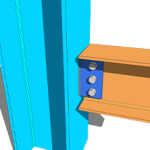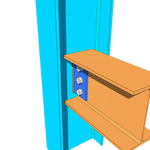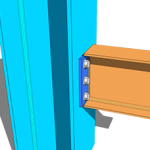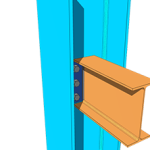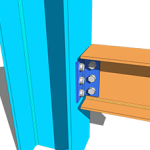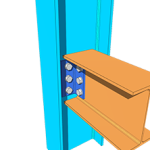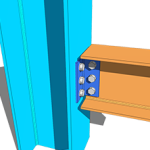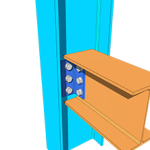The steel connections listed in this article are designed in accordance with Australian Standard 4100:2020, Australian Steel Institute Connection Handbook 1, and Australian Steel Institute Design Guides 1-5.
Universal Beam to Universal Column
The universal beam to universal column connections are one of the most common connection types used in steel design. SkyCiv’s first set of AS connections are all universal beam to universal column connections, where the orientation of the column can be change to a flange support or web support. Currently, only one connection to a node can be designed at a time. When dealing with back-to-back connections, it is advisable to take conservative assumptions on the load path.
Shear Connections
The most basic type of a steel connection is a shear connection. It is a type of connection that only deals with shear-only loads, that is no other concurrent loads are present. For the AS design, the following shear connection types are available to use:
- Web Side Plate – Beam to Column Flange
- Web Side Plate – Beam to Column Web
- Flexible End Plate – Beam to Column Flange
- Flexible End Plate – Beam to Column Web
- Single Angle – Beam to Column Flange
- Single Angle – Beam to Column Web
- Double Angle – Beam to Column Flange
- Double Angle – Beam to Column Web
- Web Side Plate – Beam to Column Flange
- Web Side Plate – Beam to Column Web
- Flexible End Plate – Beam to Column Flange
- Flexible End Plate – Beam to Column Web
- Single Angle – Beam to Column Flange
- Single Angle – Beam to Column Web
- Double Angle – Beam to Column Flange
- Double Angle – Beam to Column Web
The design of the above shear connections were mainly based on the ASI Design Guides 3, 4, and 5. The reference formulas were referenced from the AS4100:2020 manual, while the rest of the calculations or criteria were taken from the ASI Connection Handbook 1.
Bolt Group Coefficient
For flexibility on the bolt arrangement and bolt spacing, SkyCiv adapted the ICOR method and inelastic analysis in determining the bolt group coefficient C, which will then be used to calculate the bolt group shear capacity and bolt bearing capacity.
The Instantaneous Center of Rotation Method (ICOR) uses iteration to locate the IC of the bolt group. SkyCiv uses its own solver for these iterations. The location of the IC is included in the calculations, but the iterations are not shown to make the report more concise and readable.
The equation used to calculate the force per bolt using the inelastic analysis is based on the AISC Eq. (7-1) on pages 7-7 of the AISC 15th Edition Manual. The equation is shown below.
\(R = R_{ult}(1-e^{-10\Delta })^{0.55}\)
Since the bolt group capacity adapted the AISC method, the provisions in determining the design bolt eccentricity of the bolt group also follows Table 10-9 of the AISC 15th Ed. This is applicable on SkyCiv’s AS Web Side Plate connection. For Single Angle connections, both the NSL and OSL legs on the single angle are designed with load eccentricity. For Double Angle connections, only the NSL leg is designed with eccentricity since the OSL leg is symmetrically balanced about the line of force. For Flexible End Plate connections, there is no eccentricity on the load too, as the load is directly acting on the center of the bolt group. All of those bolt groups without eccentricity will then take the bolt coefficient C as the total number of bolts in the bolt group.
Fixture Types
For angle connections, the currently allowed fixture type at the beam and at the support are bolted types. The welded type is still underdevelopment and will be available soon.
Detailing Limitations
The detailing limitations or the fit-up checks on the connections are also added in the new release of AS connection design. Most of the detailing limitations are based on the ASI Design Guides 3-5, while some are based on an intuitive engineering approach.
A pass or fail result is also added for the detailing limitations check at the Analysis Tab so it can be easily identified by the user. The calculation report also produces a table, shown below, for the detailing limitations check. This way, the item that needs to be modified can be easily identified.
More Connection Types
The new release of AS connections is just the beginning of this Australian Steel Connection Design. Should you wish to add more connection types, you may contact SkyCiv support.
Want to try this new feature? Test it out through our Free Steel Connection Design Calculator.

